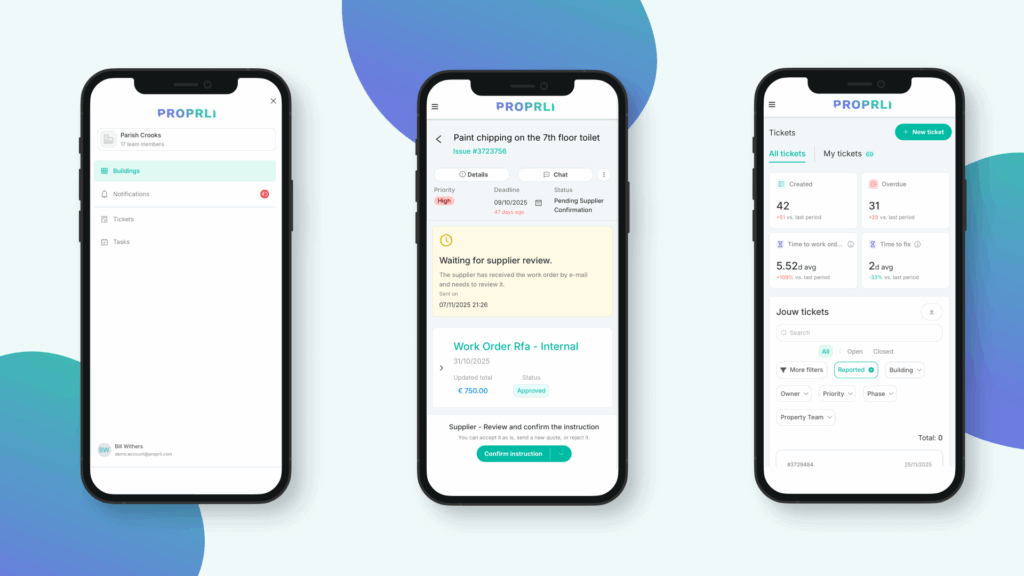Property metrics are vital for assessing and improving maintenance performance across your real estate assets. They enable those without direct ownership, such as technical property and asset managers, to improve operational effectiveness. Key indicators like rental yield and property market data play a crucial role. These measures shed light on the health and profitability of your real estate investments.
Key Takeaways
- Property metrics offer a data-driven approach to managing real estate portfolios.
- Rental yield analysis helps to assess the profitability of properties.
- Property market data analysis provides insights into market trends and performance.
- Technical property managers can optimize operational efficiency using these metrics.
- Effective use of property metrics helps to enhance the overall value of real estate investments.
Understanding Property Metrics
For technical property and asset managers, mastering property metrics is key. These metrics are essential for optimizing real estate portfolios. They serve as the quantifiable standards that steer investment decisions and gauge management’s performance. Through these metrics, real estate professionals can effectively minimize risks and boost profits.
Definition of Property Metrics
Property metrics are vital indicators of investment performance. They allow professionals to evaluate an asset’s value and performance. These insights cover rental income, operating costs, and the asset’s overall health. By leveraging specific valuation metrics, investors can make well-informed choices on property acquisition, upkeep, and sales.
Importance of Property Metrics in Real Estate
Success in real estate analytics leans heavily on tracking and analyzing property metrics. They pinpoint trends, evaluate risks, and guide strategic enhancements. Stakeholders use these indicators to refine investment strategies. This ensures not just immediate gains but also long-term value growth. Through accurate valuation metrics, managers achieve a better grasp of market dynamics. This empowers them to make decisions based on solid data.
| Metric | Function | Benefit |
|---|---|---|
| Net Operating Income (NOI) | Measures profitability | Assesses revenue generation after operating expenses |
| Capitalization Rate (Cap Rate) | Evaluates return on investment | Helps with risk assessment and valuation |
| Gross Rent Multiplier (GRM) | Estimates property value | Facilitates easy comparison of value across different properties |
Grasping these metrics is crucial for property and asset managers. It allows them to adeptly handle the real estate market’s complexities. With this knowledge, they can align their practices with financial objectives. This results in significant investment returns.
Key Performance Indicators (KPIs) for Real Estate
Key Performance Indicators (KPIs) are vital in evaluating property management effectiveness. They provide a detailed framework for measuring performance and guiding decisions. By leveraging KPIs, managers can achieve success, ensuring top-notch management of commercial properties.
What are KPIs?
KPIs are precise, measurable values that highlight the performance against main goals in property management. They span aspects from financial returns to tenant satisfaction. By monitoring these metrics, managers pinpoint improvement areas and align with stakeholders’ needs.
Common KPIs in Property Management
Commercial property metrics include several KPIs that shed light on a property’s health and success. Key metrics in property management involve:
- Net Operating Income (NOI) – It calculates the property’s profitability by deducting operating costs from earned revenue.
- Capitalization Rate (Cap Rate) – This ratio assesses return on investment, dividing NOI by property value.
- Cash Flow – Indicates the total cash movements, essential for evaluating liquidity.
- Occupancy Rates – Demonstrates rented unit percentages, vital for gauging demand and income potential.
Employing these KPIs within your management approach provides a rich overview of property results. It enables managers to make decisions that boost both efficiency and returns.
Evaluating Net Operating Income (NOI)
Net Operating Income (NOI) measures how well a property generates revenue. Understanding and calculating NOI allows managers to boost their investments’ financial health. It’s vital for making smarter decisions around real estate assets.
How to Calculate NOI
To calculate NOI, begin with the property’s total income. This includes rent and any other fees. Then, deduct the operating costs needed for upkeep and management. The formula is simple:
NOI = Total Income – Operating Expenses
Why NOI Matters for Maintenance Performance
NOI offers insights into a property’s profits, highlighting its financial wellness. Properties with a higher NOI demonstrate stronger financial stability. This can directly impact mortgage conditions and the investment’s value. It enables managers to pinpoint ways to cut costs and streamline operations.
| Property | Total Income | Operating Expenses | NOI |
|---|---|---|---|
| Property A | €120,000 | €40,000 | €80,000 |
| Property B | €150,000 | €60,000 | €90,000 |
Through steady tracking of metrics like NOI, managers enhance the property’s earnings while reducing expenses. This strategic management is key to keeping a real estate portfolio financially sound.
Capitalization Rate and Its Relevance
The Capitalization Rate, or Cap Rate, is vital in assessing real estate investments. It forecasts the return rate on a property. By mastering Cap Rate, investors unlock insights about property performance and asset worth.
Definition of Cap Rate
Cap Rate measures the relation between a property’s Net Operating Income (NOI) and its market value. It gauges investor returns and property profitability. The formula is straightforward:
- Cap Rate = (NOI / Asset Value) x 100
This figure represents the annual ROI, helping investors evaluate a property’s initial yield. It does so without factoring in financing expenses.
Using Cap Rate to Assess Maintenance Efficiency
Cap Rate goes beyond predicting investment returns. It also reflects how efficiently a property is maintained. By comparing Cap Rates with industry averages, investors pinpoint management efficiency. A high Cap Rate suggests superior operational performance and a stable asset value.
Regular Cap Rate evaluations aid in pinpointing improvement needs. A falling Cap Rate could indicate maintenance problems. Thus, the Cap Rate aligns property management with investment objectives.
| Property | NOI | Asset Value | Cap Rate |
|---|---|---|---|
| Property A | €100,000 | €1,000,000 | 10% |
| Property B | €150,000 | €1,500,000 | 10% |
Analyzing Cash Flow
Cash flow analysis is crucial for evaluating real estate investment performance. Understanding net cash after expenses allows technical managers to gauge a property’s financial state. This knowledge is vital for ensuring the financial health of their properties. Efficient cash flow management is key to maintaining or enhancing real estate value.
Importance of Cash Flow in Property Maintenance
Cash flow is essential in property maintenance, determining the funds available for repairs and upkeep. With positive cash flow, managers can promptly address maintenance needs. This action mitigates the risk of more expensive damages later. Moreover, it boosts property performance, making real estate appealing to potential tenants.
Strategies to Improve Cash Flow through Effective Maintenance
To boost cash flow and property performance, consider these strategies:
- Regular Maintenance: Conduct frequent inspections and routine upkeep to prevent major repairs.
- Efficient Expense Management: Monitor and control operational expenses to avoid unnecessary costs.
- Proactive Repairs: Address minor issues before they develop into significant problems that deplete cash flow.
- Energy Efficiency: Implement energy-saving measures to reduce utility costs.
Emphasizing these approaches helps property managers optimize their investments for long-term stability.
Operating Expense Ratio (OER): A Critical Metric
The Operating Expense Ratio (OER) greatly impacts the financial success of real estate investments. By managing property expenses wisely, operational efficiency improves. This boosts the long-term profitability of your investments.
Calculating OER for Your Properties
To calculate the OER, you divide total operating expenses by the gross operating income. This ratio shows how much income is eaten by operating costs. Keeping the OER low is vital for efficient expense management and maximizing returns.
Impact of Maintenance on OER
Maintenance deeply influences the OER. Regular, cost-effective maintenance strategies enhance operational efficiency and improve the OER. Timely upkeep and fixing small problems quickly help avoid big expenses later. This keeps operating expenses down, maintaining a desirable OER.
| Metrics | Low OER | High OER |
|---|---|---|
| Operational Efficiency | High | Low |
| Maintenance Costs | Controlled | Elevated |
| Property Expenses | Optimized | Excessive |
Tracking Occupancy Rates
Understanding and managing occupancy rates is vital for a successful real estate portfolio. Properties with high occupancy rates show strong appeal and increase rental revenue. A property that is well-maintained attracts and retains tenants consistently. This leads to steady revenue and enhances the portfolio’s stability.
The Role of Occupancy Rates in Maintenance Performance
Occupancy rates are critical for assessing a property’s condition and market position. They show how attractive a property is compared to others. Routine maintenance is key to keeping tenants. It ensures properties enjoy high occupancy rates. Neglecting maintenance can increase vacancies, hurting both immediate income and the asset’s long-term worth.
Strategies to Maintain High Occupancy Rates
To keep occupancy rates high, proactive maintenance is critical. Let’s discuss some strategies.
- Regular Inspections: By conducting regular checks, maintenance issues are spotted and resolved early. This avoids the escalation of small issues.
- Responsive Repairs: Addressing maintenance requests swiftly boosts tenant satisfaction and loyalty.
- Upgrades and Renovations: Updating amenities and shared spaces can improve a property’s attractiveness and support competitive rents.
- Open Communication: Clear communication with tenants builds trust and encourages them to renew their leases.
These methods not only maintain high occupancy rates but also strengthen a real estate portfolio’s health and growth.
Property Valation Metrics
Grasping how maintenance affects a property’s value is essential for accurate real estate assessments. Regular upkeep not only preserves a property’s condition but also markedly improves its value. This improvement impacts crucial metrics that investors consider when evaluating an investment’s worth.
How Maintenance Influences Property Value
Maintenance directly boosts property valuation by staving off wear and tear. It ensures the property remains appealing to potential buyers and renters. Such properties often have higher rents and sale prices, enhancing their investment allure. Additionally, consistent maintenance minimizes sudden hefty repair bills, protecting the property’s economic health and valuation.
Key Valuation Metrics to Monitor
Several valuation metrics are essential for determining a property’s market value. Important ones include:
- Capitalization Rate (Cap Rate): This measures a real estate investment’s rate of return, based on anticipated income versus market value.
- Gross Rent Multiplier (GRM): Used to assess if a property is worth its investment, it relates property price to gross rental income.
- Net Operating Income (NOI): This key metric shows a property’s profitability after subtracting operating expenses from total revenue.
Monitoring these metrics helps real estate experts make savvy investment choices. Regular upkeeps’ role in uplifting these metrics underscores its importance in property management.
Implementing Effective Property Management Metrics
In today’s swiftly changing real estate sector, adopting potent property management metrics is essential. By embracing technology, property managers achieve greater maintenance oversight and boost efficiency. This approach enables a streamlined operation.
Best Practices for Tracking Maintenance Performance
Maintenance tracking is pivotal for effective property management. To maximize monitoring efficiency, adhere to these guidelines:
- Regularly update maintenance logs for accurate record-keeping.
- Conduct frequent inspections to identify potential issues early.
- Implement a standardized reporting system for maintenance tasks.
Adhering to these practices enhances real estate KPIs, offering a clearer view of property health.
Utilizing Technology to Monitor Metrics
Advanced technology transforms maintenance monitoring in property management. Specialized software allows for effortless scheduling of tasks and real-time data analytics. This approach brings about precision in oversight.
By providing in-depth insights on property conditions, such technologies improve real estate KPIs. This achievement manifests in better-managed properties.
Integrating technology in property management significantly accelerates maintenance tracking. It fosters informed decision-making. Ultimately, this strategy ensures properties are well-kept, satisfying all stakeholders involved.
| Metric | Description | Benefits |
|---|---|---|
| Maintenance Tracking | Monitoring and recording maintenance activities | Ensures timely repairs and reduces unexpected costs |
| Technology Integration | Using advanced software for property management | Streamlines processes, saves time, and improves accuracy |
| Real Estate KPIs | Key Performance Indicators related to property management | Provides insights for better decision-making and investment strategies |
Conclusion
Managing property metrics well is key for optimizing real estate portfolios. They are vital for both technical property managers and asset managers. These metrics offer a systematic method to continually observe and improve maintenance operations.
Selecting the right Key Performance Indicators (KPIs) like Net Operating Income (NOI), Capitalization Rate (Cap Rate), Cash Flow, and Occupancy Rates is essential. They provide deep insights into a property’s operational efficiency and financial status. This information supports decisions that minimize risk and enhance returns on investment.
The use of technology makes monitoring and analyzing these metrics more precise and efficient. Through consistent review and proactive management, value and performance of real estate investments can be markedly improved. This achieves the strategic investment goals. Remember, property metrics are critical in real estate management success.
FAQ
What are property metrics?
Property metrics are defined standards for assessing real estate portfolios. They assist stakeholders in making informed investment choices and improving property management.
Why are property metrics important in real estate?
Through a data-driven method, property metrics aim to lower risks and boost profits. They guide investment strategies and measure the effectiveness of management. This guarantees the financial well-being and efficiency of a property.
What are Key Performance Indicators (KPIs) for real estate?
KPIs serve as critical benchmarks in evaluating the efficiency of property management. Key KPIs encompass Net Operating Income (NOI), Cap Rate, cash flow, and occupancy levels.
How do you calculate Net Operating Income (NOI)?
To determine NOI, subtract operating costs from the total income of the property. This calculation is vital for assessing the property’s ability to generate revenue and its financial status.
What is the capitalization rate (Cap Rate) in real estate?
The Cap Rate gauges a property’s investment return based on its income. It shows how NOI correlates to property value, mirroring maintenance efficiency and risk assessment.
How does cash flow impact property maintenance?
Cash flow reflects the remaining net cash after all outgoings, including upkeep costs. Managing cash flow effectively ensures there are adequate reserves for maintenance. This avoids significant repairs and enhances property functioning.
What is the Operating Expense Ratio (OER), and how is it calculated?
The OER is determined by dividing operating costs by gross operating income. It evaluates how cost-efficiently a property operates, highlighting the need for cost-effective upkeep strategies.
Why are occupancy rates important in property management?
Occupancy rates show how attractive a property is and influence rental income directly. Maintaining high occupancy rates ensures continuous revenue. This is achieved through diligent maintenance and managing tenant relations.
How does maintenance influence property valuation metrics?
Consistent and detailed maintenance boosts property value and its appeal to investors. Metrics like Cap Rate and Gross Rent Multiplier (GRM) benefit from well-kept properties.
What role does technology play in tracking property management metrics?
By integrating technology, such as specialized software, tracking metrics becomes precise and simple. It enhances the accuracy of KPIs, leading to superior investment decision-making and management.






